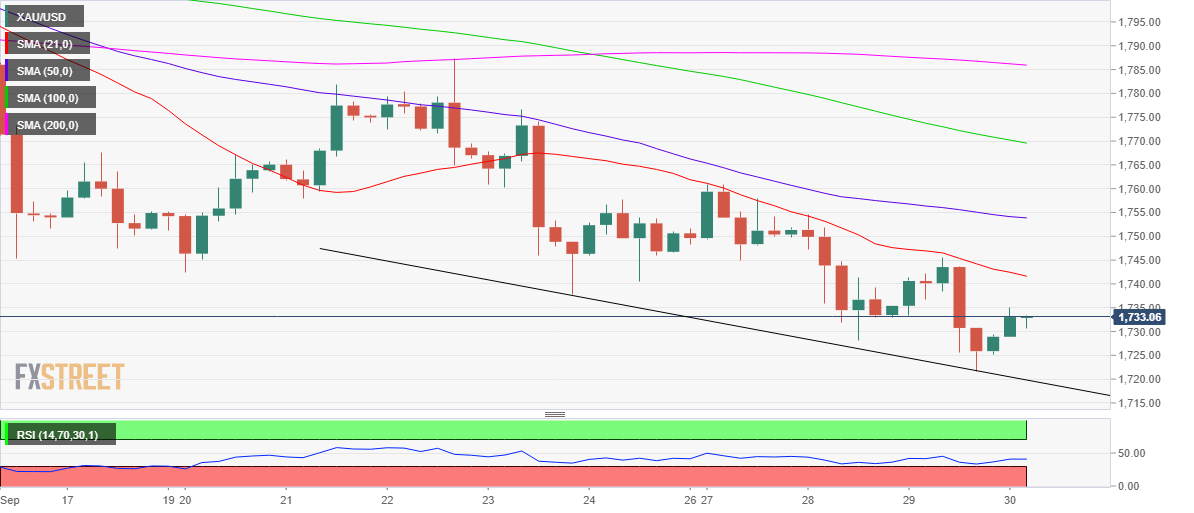- Gold price licks its wound after the three-day rout, ahead of US data.
- Focus will remain on yields and dollar amid hawkish Fed’s stance.
- Gold’s 4H chart shows $1720 as critical support while 20-SMA is tough resistance.
Gold price fell for the third day in a row on Thursday, extending the rout amid the ongoing narrative of the Fed’s tapering chances and rising inflation expectations, which kept the bullish momentum in the US dollar and the Treasury yields intact. The recent hawkish comments from Fed Chair Jerome Powell and his colleagues suggest that the world’s most powerful central bank is on track to withdraw the pandemic stimulus sooner than expected, with rate hikes on the table in 2022.
Meanwhile, concerns over a likely US government shutdown and a rebound in the US stocks also exacerbated the pain in gold price. The rising energy crisis, with petroleum problems in the Euro area and China’s power shortages reinforced stagflation concerns, boosting the dollar’s safe-haven demand at gold’s expense. Gold price hit a fresh seven-week low of $1722 before recovering slightly to settle at $1726, still down 1% on the day.
On Thursday, gold price has staged a modest recovery from fresh seven-week lows, as the market sentiment improves amid retreating Treasury yields, capping the upside in the US dollar. Upbeat Chinese Caixin Manufacturing PMI, an aversion to the US government shutdown and a rebound in metals and energy prices seem to have revived the risk-on trades. However, the further upside in gold price remains elusive, as the Fed’s hawkish expectations will continue leading the sentiment, underpinning the yields and the dollar while weighing negatively on the non-interest-bearing gold.
Also, of note remains the US final GDP release and weekly jobless claims for fresh dollar trades. A slew of speeches from the Fed officials will be closely eyed as well.
Gold Price Chart - Technical outlook
Gold: Four-hour chart
Gold’s four-hour chart shows that the price continues to extend its downtrend while trading below the 21-Simple Moving Average (SMA) at $1742.
The Relative Strength Index (RSI) turns slightly lower while below the midline, keeping the bearish view alive and kicking for gold price.
Only a four-hourly candlestick closing above the 21-SMA hurdle will create conditions for any meaningful recovery.
Up next, gold buyers will look to regain the falling 50-SMA at $1753, opening doors for a fresh rally towards the downward-sloping 100-SMA at $1770.
On the flip side, if the sellers fight back control, then a retest of the seven-week troughs at $1722 would be inevitable.
Gold bears will need to find a strong foothold below the falling trendline support at $1720, in order to flex their muscles towards the August 10 low of $1718.
The line in the sand for gold optimists is the $1700 psychological threshold.
To conclude, any recovery in gold could likely remain short-lived, as sellers would seek fresh entries at higher levels.
Information on these pages contains forward-looking statements that involve risks and uncertainties. Markets and instruments profiled on this page are for informational purposes only and should not in any way come across as a recommendation to buy or sell in these assets. You should do your own thorough research before making any investment decisions. FXStreet does not in any way guarantee that this information is free from mistakes, errors, or material misstatements. It also does not guarantee that this information is of a timely nature. Investing in Open Markets involves a great deal of risk, including the loss of all or a portion of your investment, as well as emotional distress. All risks, losses and costs associated with investing, including total loss of principal, are your responsibility. The views and opinions expressed in this article are those of the authors and do not necessarily reflect the official policy or position of FXStreet nor its advertisers. The author will not be held responsible for information that is found at the end of links posted on this page.
If not otherwise explicitly mentioned in the body of the article, at the time of writing, the author has no position in any stock mentioned in this article and no business relationship with any company mentioned. The author has not received compensation for writing this article, other than from FXStreet.
FXStreet and the author do not provide personalized recommendations. The author makes no representations as to the accuracy, completeness, or suitability of this information. FXStreet and the author will not be liable for any errors, omissions or any losses, injuries or damages arising from this information and its display or use. Errors and omissions excepted.
The author and FXStreet are not registered investment advisors and nothing in this article is intended to be investment advice.
Recommended Content
Editors’ Picks

EUR/USD recovers from two-year lows, stays below 1.0450
EUR/USD recovers modestly and trades above 1.0400 after setting a two-year low below 1.0350 following the disappointing PMI data from Germany and the Eurozone on Friday. Market focus shifts to November PMI data releases from the US.

GBP/USD falls to six-month lows below 1.2550, eyes on US PMI
GBP/USD extends its losses for the third successive session and trades at a fresh fix-month low below 1.2550 on Friday. Disappointing PMI data from the UK weigh on Pound Sterling as investors await US PMI data releases.

Gold price refreshes two-week high, looks to build on momentum beyond $2,700 mark
Gold price hits a fresh two-week top during the first half of the European session on Friday, with bulls now looking to build on the momentum further beyond the $2,700 mark. This marks the fifth successive day of a positive move and is fueled by the global flight to safety amid persistent geopolitical tensions stemming from the intensifying Russia-Ukraine war.

S&P Global PMIs set to signal US economy continued to expand in November
The S&P Global preliminary PMIs for November are likely to show little variation from the October final readings. Markets are undecided on whether the Federal Reserve will lower the policy rate again in December.

Eurozone PMI sounds the alarm about growth once more
The composite PMI dropped from 50 to 48.1, once more stressing growth concerns for the eurozone. Hard data has actually come in better than expected recently – so ahead of the December meeting, the ECB has to figure out whether this is the PMI crying wolf or whether it should take this signal seriously. We think it’s the latter.

Best Forex Brokers with Low Spreads
VERIFIED Low spreads are crucial for reducing trading costs. Explore top Forex brokers offering competitive spreads and high leverage. Compare options for EUR/USD, GBP/USD, USD/JPY, and Gold.
